Academic Report on Dementia and Diabetes Mellitus - Healthcare
VerifiedAdded on 2022/08/28
|15
|3779
|11
Report
AI Summary
This academic report provides a comprehensive analysis of dementia and diabetes mellitus, focusing on two patients, Liam and Oliver, who are experiencing these chronic health issues. The report delves into their holistic histories, clinical manifestations, and the patients' understanding of their conditions. It explores the pathophysiology of both Alzheimer's disease and Type 1 diabetes, highlighting co-existing health problems such as hypertension and rheumatoid arthritis. The report also outlines various nursing interventions, including independent, dependent, and interdependent approaches, aimed at managing the patients' conditions. Furthermore, the report discusses the treatments, medications, and lifestyle adjustments necessary for effectively managing these complex diseases. The report emphasizes the importance of understanding these chronic conditions for improved patient care.
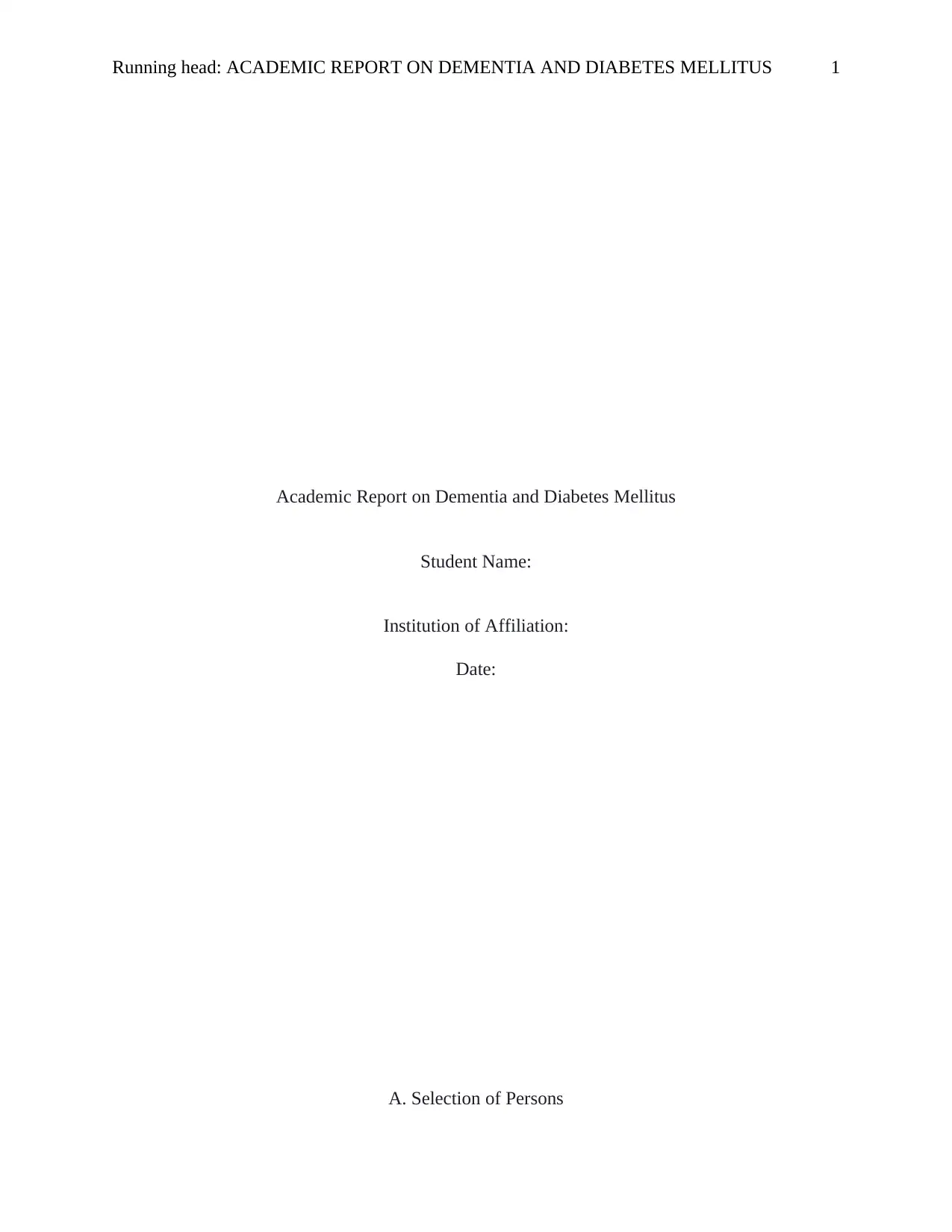
Running head: ACADEMIC REPORT ON DEMENTIA AND DIABETES MELLITUS 1
Academic Report on Dementia and Diabetes Mellitus
Student Name:
Institution of Affiliation:
Date:
A. Selection of Persons
Academic Report on Dementia and Diabetes Mellitus
Student Name:
Institution of Affiliation:
Date:
A. Selection of Persons
Paraphrase This Document
Need a fresh take? Get an instant paraphrase of this document with our AI Paraphraser
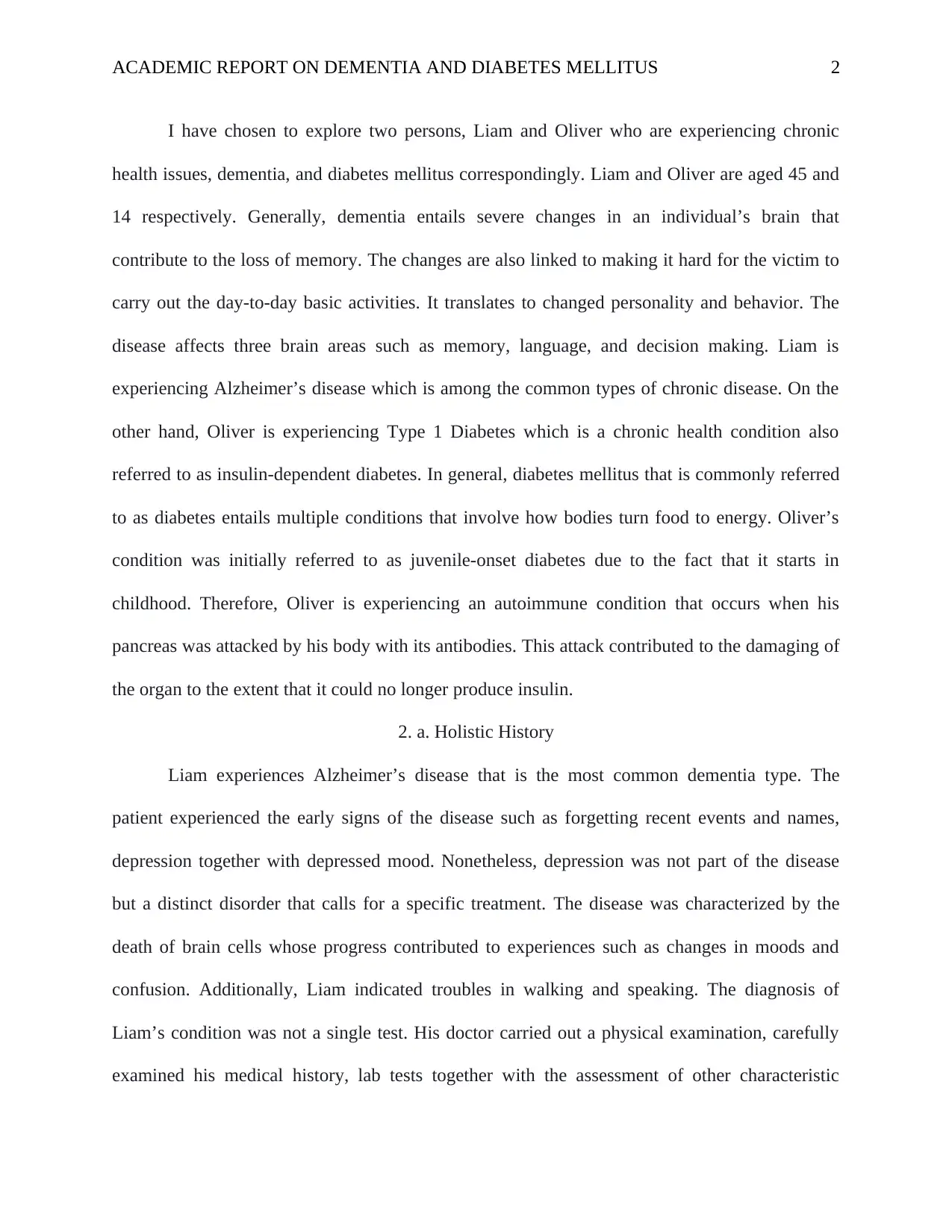
ACADEMIC REPORT ON DEMENTIA AND DIABETES MELLITUS 2
I have chosen to explore two persons, Liam and Oliver who are experiencing chronic
health issues, dementia, and diabetes mellitus correspondingly. Liam and Oliver are aged 45 and
14 respectively. Generally, dementia entails severe changes in an individual’s brain that
contribute to the loss of memory. The changes are also linked to making it hard for the victim to
carry out the day-to-day basic activities. It translates to changed personality and behavior. The
disease affects three brain areas such as memory, language, and decision making. Liam is
experiencing Alzheimer’s disease which is among the common types of chronic disease. On the
other hand, Oliver is experiencing Type 1 Diabetes which is a chronic health condition also
referred to as insulin-dependent diabetes. In general, diabetes mellitus that is commonly referred
to as diabetes entails multiple conditions that involve how bodies turn food to energy. Oliver’s
condition was initially referred to as juvenile-onset diabetes due to the fact that it starts in
childhood. Therefore, Oliver is experiencing an autoimmune condition that occurs when his
pancreas was attacked by his body with its antibodies. This attack contributed to the damaging of
the organ to the extent that it could no longer produce insulin.
2. a. Holistic History
Liam experiences Alzheimer’s disease that is the most common dementia type. The
patient experienced the early signs of the disease such as forgetting recent events and names,
depression together with depressed mood. Nonetheless, depression was not part of the disease
but a distinct disorder that calls for a specific treatment. The disease was characterized by the
death of brain cells whose progress contributed to experiences such as changes in moods and
confusion. Additionally, Liam indicated troubles in walking and speaking. The diagnosis of
Liam’s condition was not a single test. His doctor carried out a physical examination, carefully
examined his medical history, lab tests together with the assessment of other characteristic
I have chosen to explore two persons, Liam and Oliver who are experiencing chronic
health issues, dementia, and diabetes mellitus correspondingly. Liam and Oliver are aged 45 and
14 respectively. Generally, dementia entails severe changes in an individual’s brain that
contribute to the loss of memory. The changes are also linked to making it hard for the victim to
carry out the day-to-day basic activities. It translates to changed personality and behavior. The
disease affects three brain areas such as memory, language, and decision making. Liam is
experiencing Alzheimer’s disease which is among the common types of chronic disease. On the
other hand, Oliver is experiencing Type 1 Diabetes which is a chronic health condition also
referred to as insulin-dependent diabetes. In general, diabetes mellitus that is commonly referred
to as diabetes entails multiple conditions that involve how bodies turn food to energy. Oliver’s
condition was initially referred to as juvenile-onset diabetes due to the fact that it starts in
childhood. Therefore, Oliver is experiencing an autoimmune condition that occurs when his
pancreas was attacked by his body with its antibodies. This attack contributed to the damaging of
the organ to the extent that it could no longer produce insulin.
2. a. Holistic History
Liam experiences Alzheimer’s disease that is the most common dementia type. The
patient experienced the early signs of the disease such as forgetting recent events and names,
depression together with depressed mood. Nonetheless, depression was not part of the disease
but a distinct disorder that calls for a specific treatment. The disease was characterized by the
death of brain cells whose progress contributed to experiences such as changes in moods and
confusion. Additionally, Liam indicated troubles in walking and speaking. The diagnosis of
Liam’s condition was not a single test. His doctor carried out a physical examination, carefully
examined his medical history, lab tests together with the assessment of other characteristic
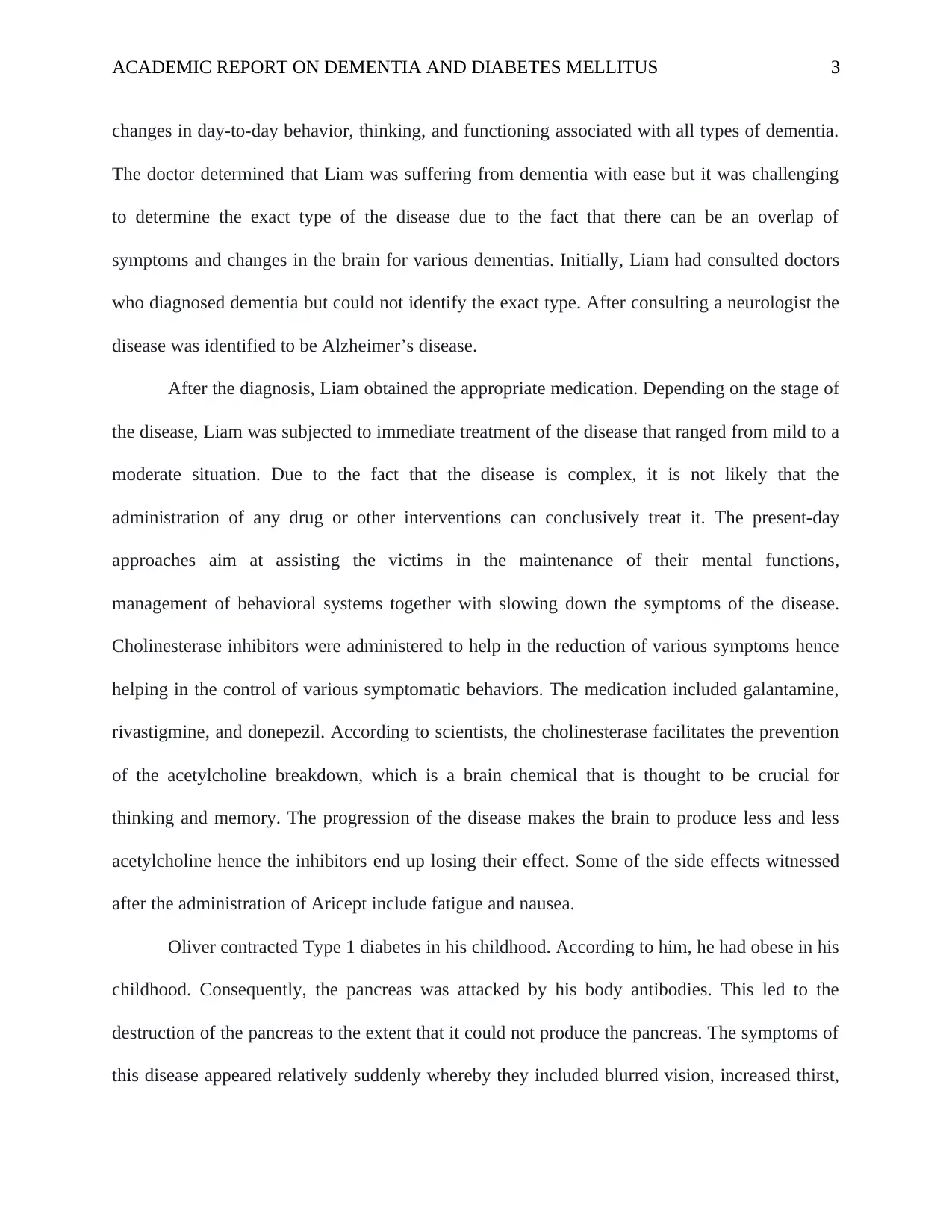
ACADEMIC REPORT ON DEMENTIA AND DIABETES MELLITUS 3
changes in day-to-day behavior, thinking, and functioning associated with all types of dementia.
The doctor determined that Liam was suffering from dementia with ease but it was challenging
to determine the exact type of the disease due to the fact that there can be an overlap of
symptoms and changes in the brain for various dementias. Initially, Liam had consulted doctors
who diagnosed dementia but could not identify the exact type. After consulting a neurologist the
disease was identified to be Alzheimer’s disease.
After the diagnosis, Liam obtained the appropriate medication. Depending on the stage of
the disease, Liam was subjected to immediate treatment of the disease that ranged from mild to a
moderate situation. Due to the fact that the disease is complex, it is not likely that the
administration of any drug or other interventions can conclusively treat it. The present-day
approaches aim at assisting the victims in the maintenance of their mental functions,
management of behavioral systems together with slowing down the symptoms of the disease.
Cholinesterase inhibitors were administered to help in the reduction of various symptoms hence
helping in the control of various symptomatic behaviors. The medication included galantamine,
rivastigmine, and donepezil. According to scientists, the cholinesterase facilitates the prevention
of the acetylcholine breakdown, which is a brain chemical that is thought to be crucial for
thinking and memory. The progression of the disease makes the brain to produce less and less
acetylcholine hence the inhibitors end up losing their effect. Some of the side effects witnessed
after the administration of Aricept include fatigue and nausea.
Oliver contracted Type 1 diabetes in his childhood. According to him, he had obese in his
childhood. Consequently, the pancreas was attacked by his body antibodies. This led to the
destruction of the pancreas to the extent that it could not produce the pancreas. The symptoms of
this disease appeared relatively suddenly whereby they included blurred vision, increased thirst,
changes in day-to-day behavior, thinking, and functioning associated with all types of dementia.
The doctor determined that Liam was suffering from dementia with ease but it was challenging
to determine the exact type of the disease due to the fact that there can be an overlap of
symptoms and changes in the brain for various dementias. Initially, Liam had consulted doctors
who diagnosed dementia but could not identify the exact type. After consulting a neurologist the
disease was identified to be Alzheimer’s disease.
After the diagnosis, Liam obtained the appropriate medication. Depending on the stage of
the disease, Liam was subjected to immediate treatment of the disease that ranged from mild to a
moderate situation. Due to the fact that the disease is complex, it is not likely that the
administration of any drug or other interventions can conclusively treat it. The present-day
approaches aim at assisting the victims in the maintenance of their mental functions,
management of behavioral systems together with slowing down the symptoms of the disease.
Cholinesterase inhibitors were administered to help in the reduction of various symptoms hence
helping in the control of various symptomatic behaviors. The medication included galantamine,
rivastigmine, and donepezil. According to scientists, the cholinesterase facilitates the prevention
of the acetylcholine breakdown, which is a brain chemical that is thought to be crucial for
thinking and memory. The progression of the disease makes the brain to produce less and less
acetylcholine hence the inhibitors end up losing their effect. Some of the side effects witnessed
after the administration of Aricept include fatigue and nausea.
Oliver contracted Type 1 diabetes in his childhood. According to him, he had obese in his
childhood. Consequently, the pancreas was attacked by his body antibodies. This led to the
destruction of the pancreas to the extent that it could not produce the pancreas. The symptoms of
this disease appeared relatively suddenly whereby they included blurred vision, increased thirst,
⊘ This is a preview!⊘
Do you want full access?
Subscribe today to unlock all pages.

Trusted by 1+ million students worldwide
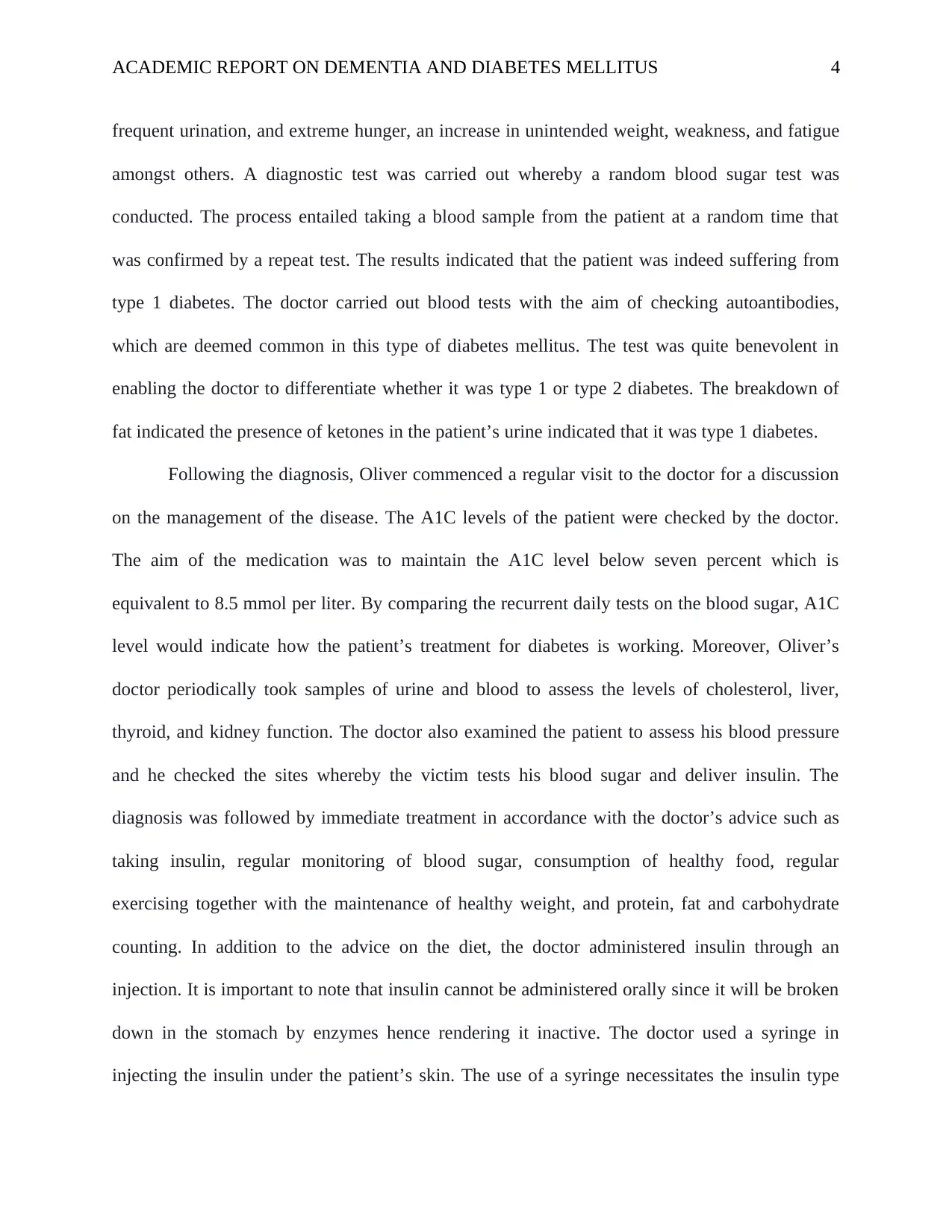
ACADEMIC REPORT ON DEMENTIA AND DIABETES MELLITUS 4
frequent urination, and extreme hunger, an increase in unintended weight, weakness, and fatigue
amongst others. A diagnostic test was carried out whereby a random blood sugar test was
conducted. The process entailed taking a blood sample from the patient at a random time that
was confirmed by a repeat test. The results indicated that the patient was indeed suffering from
type 1 diabetes. The doctor carried out blood tests with the aim of checking autoantibodies,
which are deemed common in this type of diabetes mellitus. The test was quite benevolent in
enabling the doctor to differentiate whether it was type 1 or type 2 diabetes. The breakdown of
fat indicated the presence of ketones in the patient’s urine indicated that it was type 1 diabetes.
Following the diagnosis, Oliver commenced a regular visit to the doctor for a discussion
on the management of the disease. The A1C levels of the patient were checked by the doctor.
The aim of the medication was to maintain the A1C level below seven percent which is
equivalent to 8.5 mmol per liter. By comparing the recurrent daily tests on the blood sugar, A1C
level would indicate how the patient’s treatment for diabetes is working. Moreover, Oliver’s
doctor periodically took samples of urine and blood to assess the levels of cholesterol, liver,
thyroid, and kidney function. The doctor also examined the patient to assess his blood pressure
and he checked the sites whereby the victim tests his blood sugar and deliver insulin. The
diagnosis was followed by immediate treatment in accordance with the doctor’s advice such as
taking insulin, regular monitoring of blood sugar, consumption of healthy food, regular
exercising together with the maintenance of healthy weight, and protein, fat and carbohydrate
counting. In addition to the advice on the diet, the doctor administered insulin through an
injection. It is important to note that insulin cannot be administered orally since it will be broken
down in the stomach by enzymes hence rendering it inactive. The doctor used a syringe in
injecting the insulin under the patient’s skin. The use of a syringe necessitates the insulin type
frequent urination, and extreme hunger, an increase in unintended weight, weakness, and fatigue
amongst others. A diagnostic test was carried out whereby a random blood sugar test was
conducted. The process entailed taking a blood sample from the patient at a random time that
was confirmed by a repeat test. The results indicated that the patient was indeed suffering from
type 1 diabetes. The doctor carried out blood tests with the aim of checking autoantibodies,
which are deemed common in this type of diabetes mellitus. The test was quite benevolent in
enabling the doctor to differentiate whether it was type 1 or type 2 diabetes. The breakdown of
fat indicated the presence of ketones in the patient’s urine indicated that it was type 1 diabetes.
Following the diagnosis, Oliver commenced a regular visit to the doctor for a discussion
on the management of the disease. The A1C levels of the patient were checked by the doctor.
The aim of the medication was to maintain the A1C level below seven percent which is
equivalent to 8.5 mmol per liter. By comparing the recurrent daily tests on the blood sugar, A1C
level would indicate how the patient’s treatment for diabetes is working. Moreover, Oliver’s
doctor periodically took samples of urine and blood to assess the levels of cholesterol, liver,
thyroid, and kidney function. The doctor also examined the patient to assess his blood pressure
and he checked the sites whereby the victim tests his blood sugar and deliver insulin. The
diagnosis was followed by immediate treatment in accordance with the doctor’s advice such as
taking insulin, regular monitoring of blood sugar, consumption of healthy food, regular
exercising together with the maintenance of healthy weight, and protein, fat and carbohydrate
counting. In addition to the advice on the diet, the doctor administered insulin through an
injection. It is important to note that insulin cannot be administered orally since it will be broken
down in the stomach by enzymes hence rendering it inactive. The doctor used a syringe in
injecting the insulin under the patient’s skin. The use of a syringe necessitates the insulin type
Paraphrase This Document
Need a fresh take? Get an instant paraphrase of this document with our AI Paraphraser
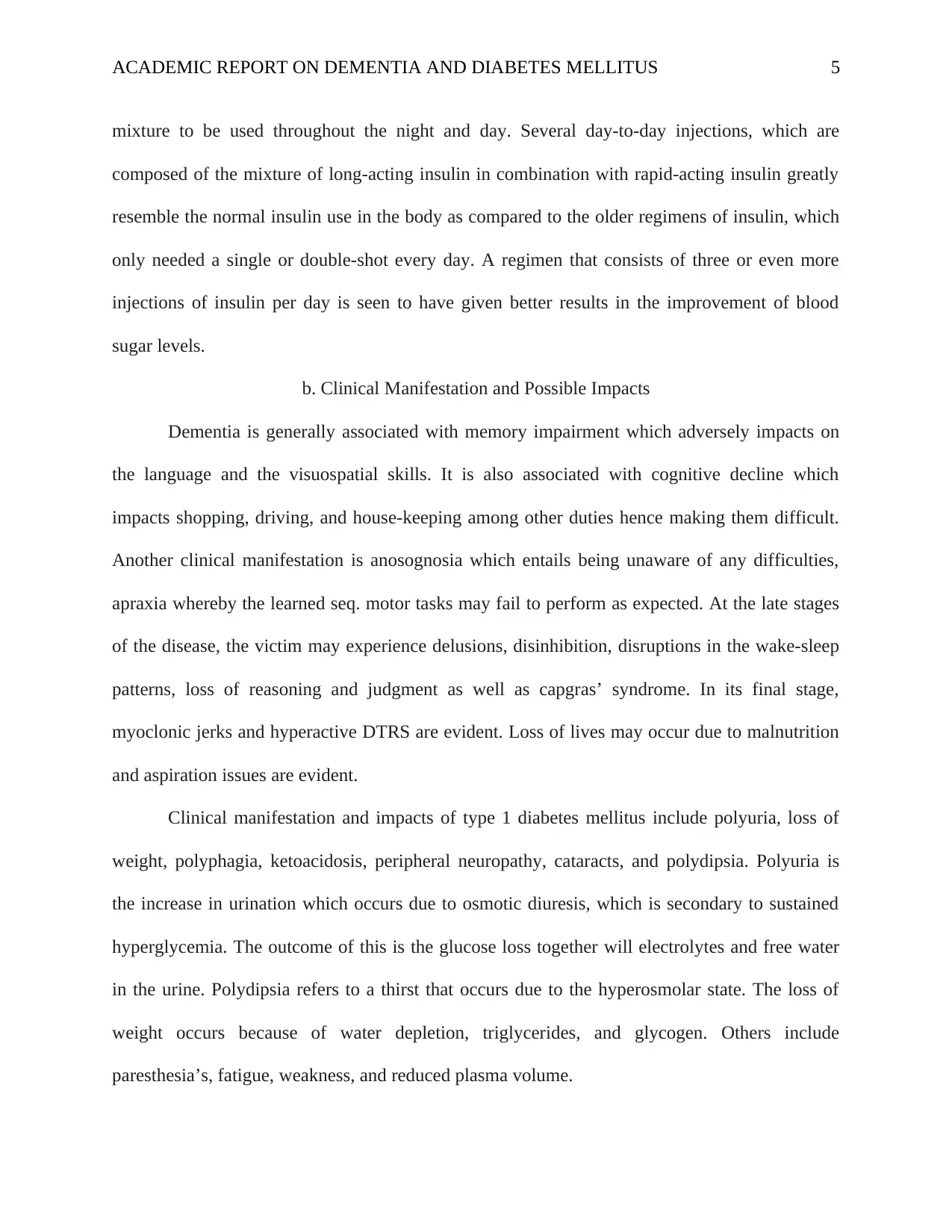
ACADEMIC REPORT ON DEMENTIA AND DIABETES MELLITUS 5
mixture to be used throughout the night and day. Several day-to-day injections, which are
composed of the mixture of long-acting insulin in combination with rapid-acting insulin greatly
resemble the normal insulin use in the body as compared to the older regimens of insulin, which
only needed a single or double-shot every day. A regimen that consists of three or even more
injections of insulin per day is seen to have given better results in the improvement of blood
sugar levels.
b. Clinical Manifestation and Possible Impacts
Dementia is generally associated with memory impairment which adversely impacts on
the language and the visuospatial skills. It is also associated with cognitive decline which
impacts shopping, driving, and house-keeping among other duties hence making them difficult.
Another clinical manifestation is anosognosia which entails being unaware of any difficulties,
apraxia whereby the learned seq. motor tasks may fail to perform as expected. At the late stages
of the disease, the victim may experience delusions, disinhibition, disruptions in the wake-sleep
patterns, loss of reasoning and judgment as well as capgras’ syndrome. In its final stage,
myoclonic jerks and hyperactive DTRS are evident. Loss of lives may occur due to malnutrition
and aspiration issues are evident.
Clinical manifestation and impacts of type 1 diabetes mellitus include polyuria, loss of
weight, polyphagia, ketoacidosis, peripheral neuropathy, cataracts, and polydipsia. Polyuria is
the increase in urination which occurs due to osmotic diuresis, which is secondary to sustained
hyperglycemia. The outcome of this is the glucose loss together will electrolytes and free water
in the urine. Polydipsia refers to a thirst that occurs due to the hyperosmolar state. The loss of
weight occurs because of water depletion, triglycerides, and glycogen. Others include
paresthesia’s, fatigue, weakness, and reduced plasma volume.
mixture to be used throughout the night and day. Several day-to-day injections, which are
composed of the mixture of long-acting insulin in combination with rapid-acting insulin greatly
resemble the normal insulin use in the body as compared to the older regimens of insulin, which
only needed a single or double-shot every day. A regimen that consists of three or even more
injections of insulin per day is seen to have given better results in the improvement of blood
sugar levels.
b. Clinical Manifestation and Possible Impacts
Dementia is generally associated with memory impairment which adversely impacts on
the language and the visuospatial skills. It is also associated with cognitive decline which
impacts shopping, driving, and house-keeping among other duties hence making them difficult.
Another clinical manifestation is anosognosia which entails being unaware of any difficulties,
apraxia whereby the learned seq. motor tasks may fail to perform as expected. At the late stages
of the disease, the victim may experience delusions, disinhibition, disruptions in the wake-sleep
patterns, loss of reasoning and judgment as well as capgras’ syndrome. In its final stage,
myoclonic jerks and hyperactive DTRS are evident. Loss of lives may occur due to malnutrition
and aspiration issues are evident.
Clinical manifestation and impacts of type 1 diabetes mellitus include polyuria, loss of
weight, polyphagia, ketoacidosis, peripheral neuropathy, cataracts, and polydipsia. Polyuria is
the increase in urination which occurs due to osmotic diuresis, which is secondary to sustained
hyperglycemia. The outcome of this is the glucose loss together will electrolytes and free water
in the urine. Polydipsia refers to a thirst that occurs due to the hyperosmolar state. The loss of
weight occurs because of water depletion, triglycerides, and glycogen. Others include
paresthesia’s, fatigue, weakness, and reduced plasma volume.
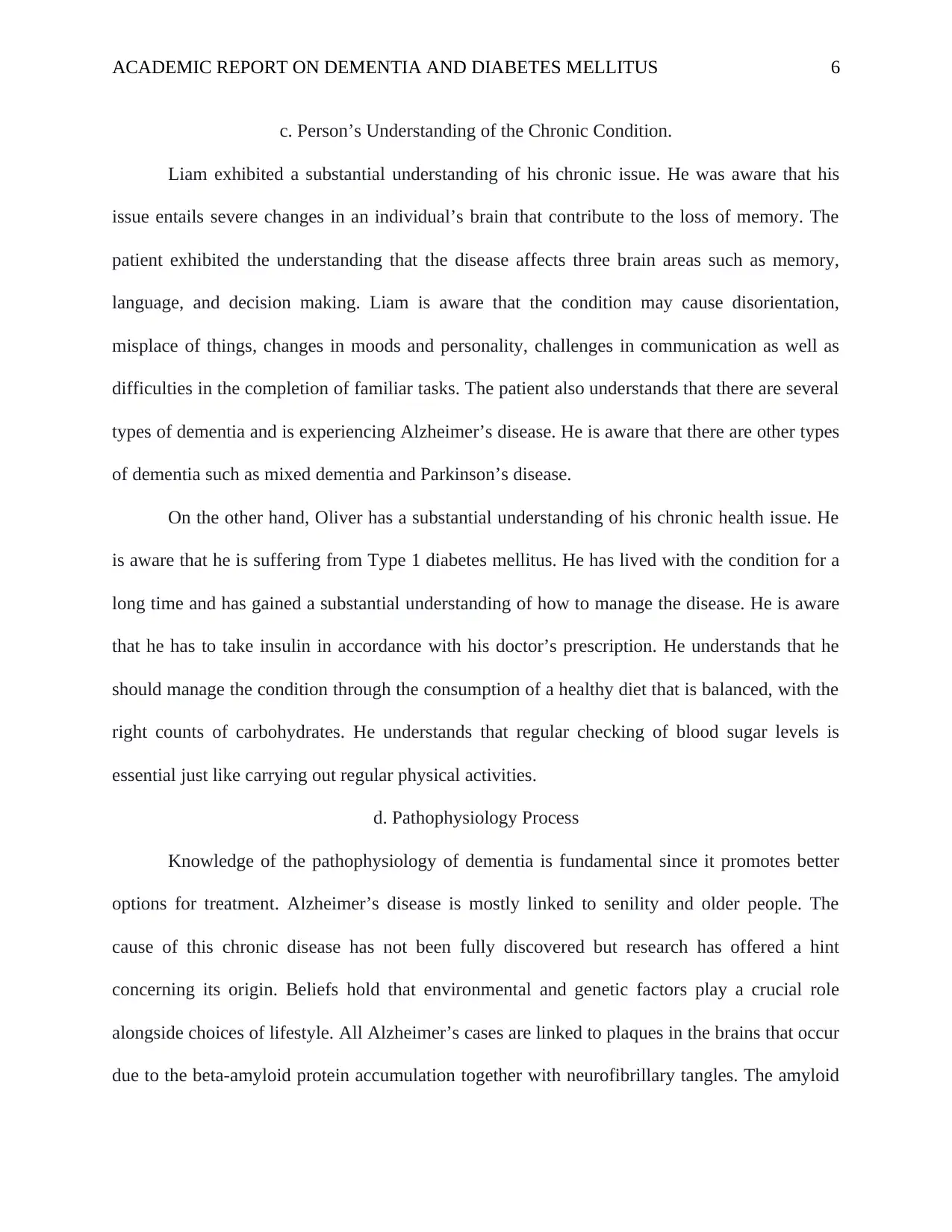
ACADEMIC REPORT ON DEMENTIA AND DIABETES MELLITUS 6
c. Person’s Understanding of the Chronic Condition.
Liam exhibited a substantial understanding of his chronic issue. He was aware that his
issue entails severe changes in an individual’s brain that contribute to the loss of memory. The
patient exhibited the understanding that the disease affects three brain areas such as memory,
language, and decision making. Liam is aware that the condition may cause disorientation,
misplace of things, changes in moods and personality, challenges in communication as well as
difficulties in the completion of familiar tasks. The patient also understands that there are several
types of dementia and is experiencing Alzheimer’s disease. He is aware that there are other types
of dementia such as mixed dementia and Parkinson’s disease.
On the other hand, Oliver has a substantial understanding of his chronic health issue. He
is aware that he is suffering from Type 1 diabetes mellitus. He has lived with the condition for a
long time and has gained a substantial understanding of how to manage the disease. He is aware
that he has to take insulin in accordance with his doctor’s prescription. He understands that he
should manage the condition through the consumption of a healthy diet that is balanced, with the
right counts of carbohydrates. He understands that regular checking of blood sugar levels is
essential just like carrying out regular physical activities.
d. Pathophysiology Process
Knowledge of the pathophysiology of dementia is fundamental since it promotes better
options for treatment. Alzheimer’s disease is mostly linked to senility and older people. The
cause of this chronic disease has not been fully discovered but research has offered a hint
concerning its origin. Beliefs hold that environmental and genetic factors play a crucial role
alongside choices of lifestyle. All Alzheimer’s cases are linked to plaques in the brains that occur
due to the beta-amyloid protein accumulation together with neurofibrillary tangles. The amyloid
c. Person’s Understanding of the Chronic Condition.
Liam exhibited a substantial understanding of his chronic issue. He was aware that his
issue entails severe changes in an individual’s brain that contribute to the loss of memory. The
patient exhibited the understanding that the disease affects three brain areas such as memory,
language, and decision making. Liam is aware that the condition may cause disorientation,
misplace of things, changes in moods and personality, challenges in communication as well as
difficulties in the completion of familiar tasks. The patient also understands that there are several
types of dementia and is experiencing Alzheimer’s disease. He is aware that there are other types
of dementia such as mixed dementia and Parkinson’s disease.
On the other hand, Oliver has a substantial understanding of his chronic health issue. He
is aware that he is suffering from Type 1 diabetes mellitus. He has lived with the condition for a
long time and has gained a substantial understanding of how to manage the disease. He is aware
that he has to take insulin in accordance with his doctor’s prescription. He understands that he
should manage the condition through the consumption of a healthy diet that is balanced, with the
right counts of carbohydrates. He understands that regular checking of blood sugar levels is
essential just like carrying out regular physical activities.
d. Pathophysiology Process
Knowledge of the pathophysiology of dementia is fundamental since it promotes better
options for treatment. Alzheimer’s disease is mostly linked to senility and older people. The
cause of this chronic disease has not been fully discovered but research has offered a hint
concerning its origin. Beliefs hold that environmental and genetic factors play a crucial role
alongside choices of lifestyle. All Alzheimer’s cases are linked to plaques in the brains that occur
due to the beta-amyloid protein accumulation together with neurofibrillary tangles. The amyloid
⊘ This is a preview!⊘
Do you want full access?
Subscribe today to unlock all pages.

Trusted by 1+ million students worldwide
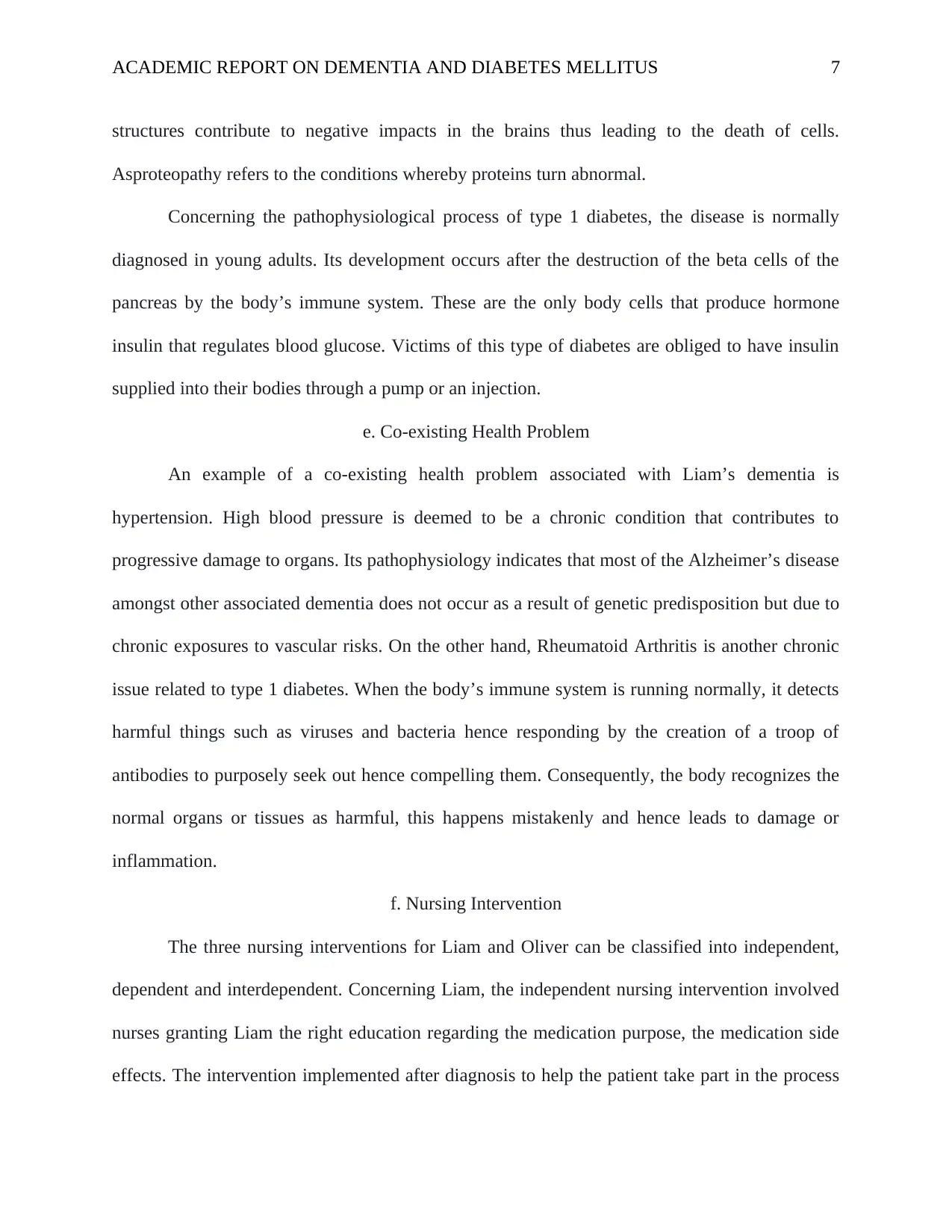
ACADEMIC REPORT ON DEMENTIA AND DIABETES MELLITUS 7
structures contribute to negative impacts in the brains thus leading to the death of cells.
Asproteopathy refers to the conditions whereby proteins turn abnormal.
Concerning the pathophysiological process of type 1 diabetes, the disease is normally
diagnosed in young adults. Its development occurs after the destruction of the beta cells of the
pancreas by the body’s immune system. These are the only body cells that produce hormone
insulin that regulates blood glucose. Victims of this type of diabetes are obliged to have insulin
supplied into their bodies through a pump or an injection.
e. Co-existing Health Problem
An example of a co-existing health problem associated with Liam’s dementia is
hypertension. High blood pressure is deemed to be a chronic condition that contributes to
progressive damage to organs. Its pathophysiology indicates that most of the Alzheimer’s disease
amongst other associated dementia does not occur as a result of genetic predisposition but due to
chronic exposures to vascular risks. On the other hand, Rheumatoid Arthritis is another chronic
issue related to type 1 diabetes. When the body’s immune system is running normally, it detects
harmful things such as viruses and bacteria hence responding by the creation of a troop of
antibodies to purposely seek out hence compelling them. Consequently, the body recognizes the
normal organs or tissues as harmful, this happens mistakenly and hence leads to damage or
inflammation.
f. Nursing Intervention
The three nursing interventions for Liam and Oliver can be classified into independent,
dependent and interdependent. Concerning Liam, the independent nursing intervention involved
nurses granting Liam the right education regarding the medication purpose, the medication side
effects. The intervention implemented after diagnosis to help the patient take part in the process
structures contribute to negative impacts in the brains thus leading to the death of cells.
Asproteopathy refers to the conditions whereby proteins turn abnormal.
Concerning the pathophysiological process of type 1 diabetes, the disease is normally
diagnosed in young adults. Its development occurs after the destruction of the beta cells of the
pancreas by the body’s immune system. These are the only body cells that produce hormone
insulin that regulates blood glucose. Victims of this type of diabetes are obliged to have insulin
supplied into their bodies through a pump or an injection.
e. Co-existing Health Problem
An example of a co-existing health problem associated with Liam’s dementia is
hypertension. High blood pressure is deemed to be a chronic condition that contributes to
progressive damage to organs. Its pathophysiology indicates that most of the Alzheimer’s disease
amongst other associated dementia does not occur as a result of genetic predisposition but due to
chronic exposures to vascular risks. On the other hand, Rheumatoid Arthritis is another chronic
issue related to type 1 diabetes. When the body’s immune system is running normally, it detects
harmful things such as viruses and bacteria hence responding by the creation of a troop of
antibodies to purposely seek out hence compelling them. Consequently, the body recognizes the
normal organs or tissues as harmful, this happens mistakenly and hence leads to damage or
inflammation.
f. Nursing Intervention
The three nursing interventions for Liam and Oliver can be classified into independent,
dependent and interdependent. Concerning Liam, the independent nursing intervention involved
nurses granting Liam the right education regarding the medication purpose, the medication side
effects. The intervention implemented after diagnosis to help the patient take part in the process
Paraphrase This Document
Need a fresh take? Get an instant paraphrase of this document with our AI Paraphraser
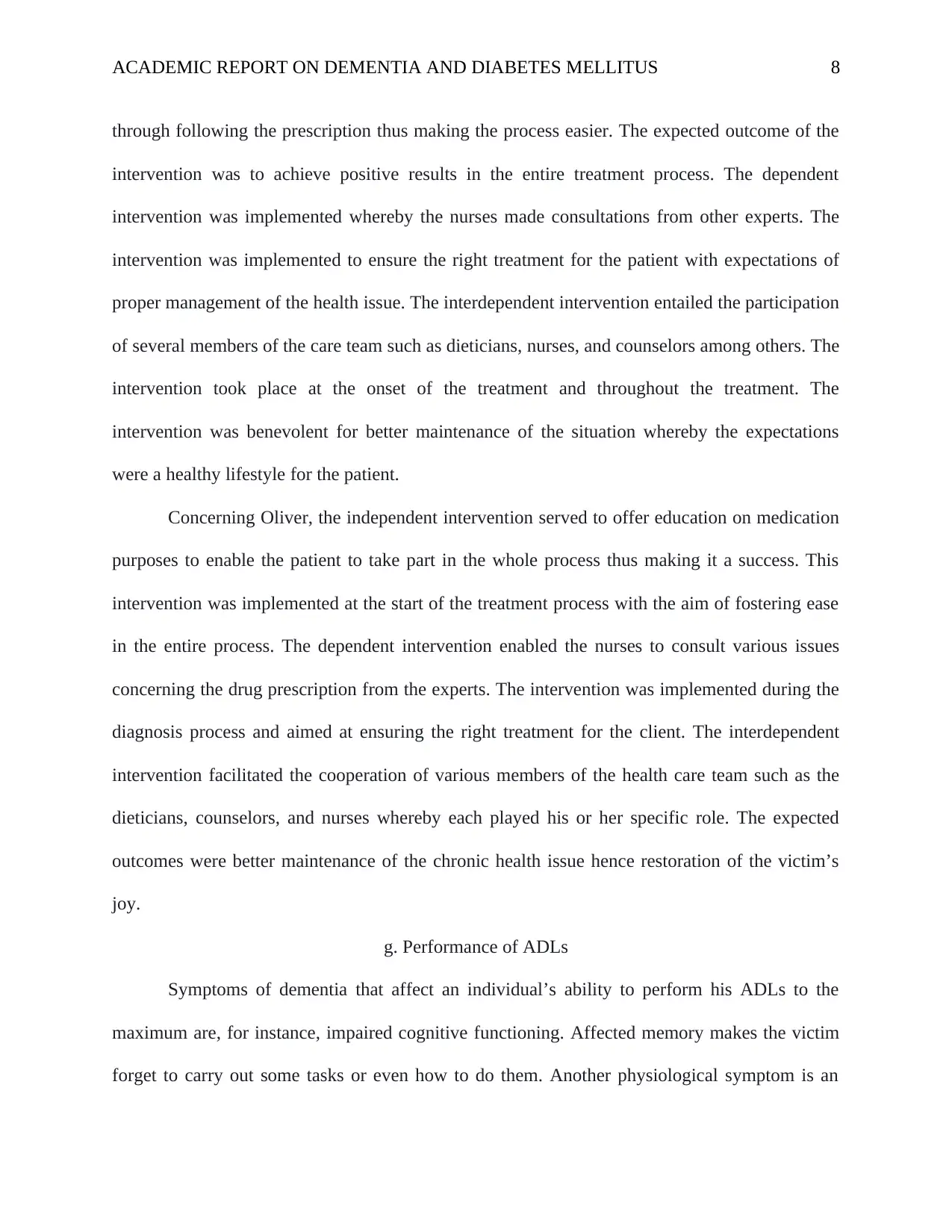
ACADEMIC REPORT ON DEMENTIA AND DIABETES MELLITUS 8
through following the prescription thus making the process easier. The expected outcome of the
intervention was to achieve positive results in the entire treatment process. The dependent
intervention was implemented whereby the nurses made consultations from other experts. The
intervention was implemented to ensure the right treatment for the patient with expectations of
proper management of the health issue. The interdependent intervention entailed the participation
of several members of the care team such as dieticians, nurses, and counselors among others. The
intervention took place at the onset of the treatment and throughout the treatment. The
intervention was benevolent for better maintenance of the situation whereby the expectations
were a healthy lifestyle for the patient.
Concerning Oliver, the independent intervention served to offer education on medication
purposes to enable the patient to take part in the whole process thus making it a success. This
intervention was implemented at the start of the treatment process with the aim of fostering ease
in the entire process. The dependent intervention enabled the nurses to consult various issues
concerning the drug prescription from the experts. The intervention was implemented during the
diagnosis process and aimed at ensuring the right treatment for the client. The interdependent
intervention facilitated the cooperation of various members of the health care team such as the
dieticians, counselors, and nurses whereby each played his or her specific role. The expected
outcomes were better maintenance of the chronic health issue hence restoration of the victim’s
joy.
g. Performance of ADLs
Symptoms of dementia that affect an individual’s ability to perform his ADLs to the
maximum are, for instance, impaired cognitive functioning. Affected memory makes the victim
forget to carry out some tasks or even how to do them. Another physiological symptom is an
through following the prescription thus making the process easier. The expected outcome of the
intervention was to achieve positive results in the entire treatment process. The dependent
intervention was implemented whereby the nurses made consultations from other experts. The
intervention was implemented to ensure the right treatment for the patient with expectations of
proper management of the health issue. The interdependent intervention entailed the participation
of several members of the care team such as dieticians, nurses, and counselors among others. The
intervention took place at the onset of the treatment and throughout the treatment. The
intervention was benevolent for better maintenance of the situation whereby the expectations
were a healthy lifestyle for the patient.
Concerning Oliver, the independent intervention served to offer education on medication
purposes to enable the patient to take part in the whole process thus making it a success. This
intervention was implemented at the start of the treatment process with the aim of fostering ease
in the entire process. The dependent intervention enabled the nurses to consult various issues
concerning the drug prescription from the experts. The intervention was implemented during the
diagnosis process and aimed at ensuring the right treatment for the client. The interdependent
intervention facilitated the cooperation of various members of the health care team such as the
dieticians, counselors, and nurses whereby each played his or her specific role. The expected
outcomes were better maintenance of the chronic health issue hence restoration of the victim’s
joy.
g. Performance of ADLs
Symptoms of dementia that affect an individual’s ability to perform his ADLs to the
maximum are, for instance, impaired cognitive functioning. Affected memory makes the victim
forget to carry out some tasks or even how to do them. Another physiological symptom is an
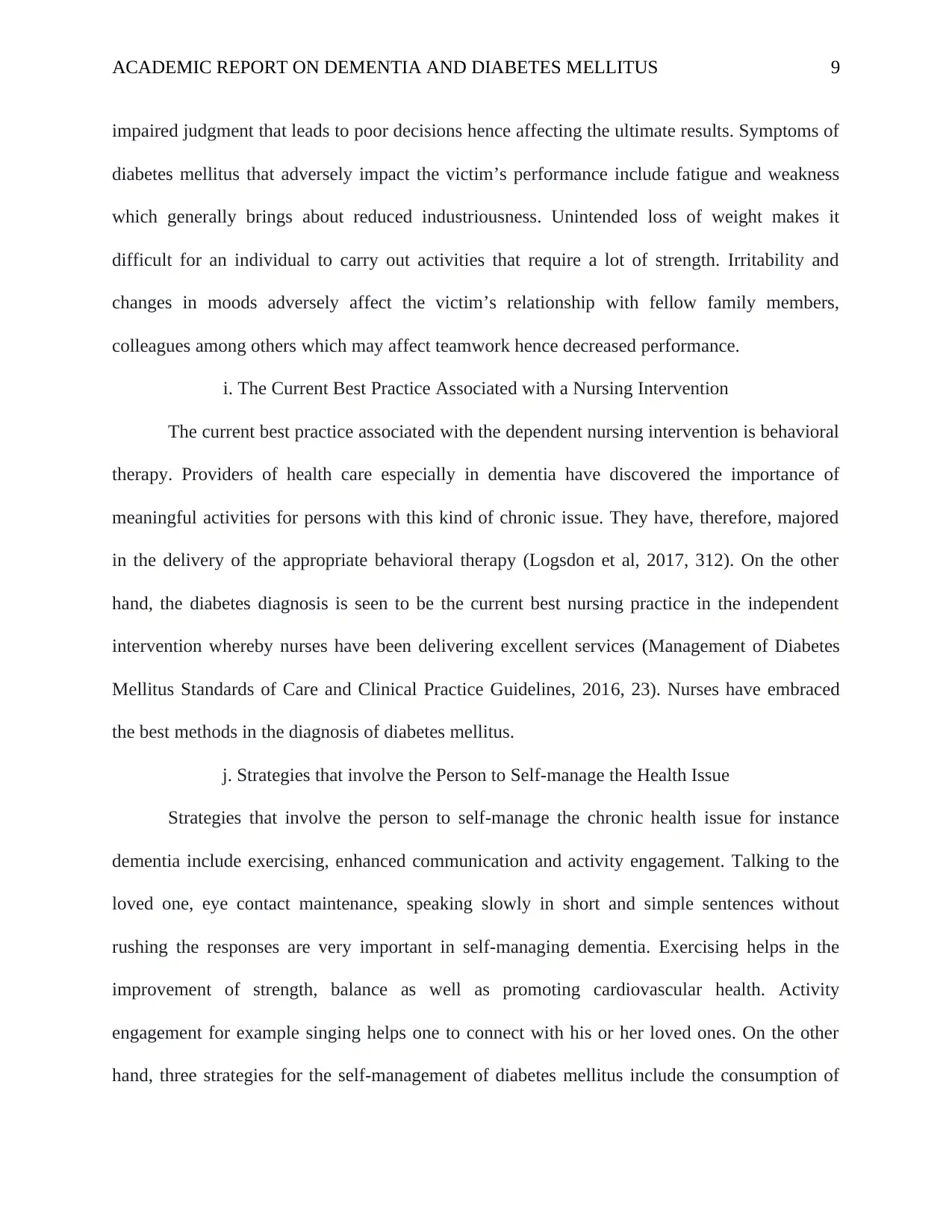
ACADEMIC REPORT ON DEMENTIA AND DIABETES MELLITUS 9
impaired judgment that leads to poor decisions hence affecting the ultimate results. Symptoms of
diabetes mellitus that adversely impact the victim’s performance include fatigue and weakness
which generally brings about reduced industriousness. Unintended loss of weight makes it
difficult for an individual to carry out activities that require a lot of strength. Irritability and
changes in moods adversely affect the victim’s relationship with fellow family members,
colleagues among others which may affect teamwork hence decreased performance.
i. The Current Best Practice Associated with a Nursing Intervention
The current best practice associated with the dependent nursing intervention is behavioral
therapy. Providers of health care especially in dementia have discovered the importance of
meaningful activities for persons with this kind of chronic issue. They have, therefore, majored
in the delivery of the appropriate behavioral therapy (Logsdon et al, 2017, 312). On the other
hand, the diabetes diagnosis is seen to be the current best nursing practice in the independent
intervention whereby nurses have been delivering excellent services (Management of Diabetes
Mellitus Standards of Care and Clinical Practice Guidelines, 2016, 23). Nurses have embraced
the best methods in the diagnosis of diabetes mellitus.
j. Strategies that involve the Person to Self-manage the Health Issue
Strategies that involve the person to self-manage the chronic health issue for instance
dementia include exercising, enhanced communication and activity engagement. Talking to the
loved one, eye contact maintenance, speaking slowly in short and simple sentences without
rushing the responses are very important in self-managing dementia. Exercising helps in the
improvement of strength, balance as well as promoting cardiovascular health. Activity
engagement for example singing helps one to connect with his or her loved ones. On the other
hand, three strategies for the self-management of diabetes mellitus include the consumption of
impaired judgment that leads to poor decisions hence affecting the ultimate results. Symptoms of
diabetes mellitus that adversely impact the victim’s performance include fatigue and weakness
which generally brings about reduced industriousness. Unintended loss of weight makes it
difficult for an individual to carry out activities that require a lot of strength. Irritability and
changes in moods adversely affect the victim’s relationship with fellow family members,
colleagues among others which may affect teamwork hence decreased performance.
i. The Current Best Practice Associated with a Nursing Intervention
The current best practice associated with the dependent nursing intervention is behavioral
therapy. Providers of health care especially in dementia have discovered the importance of
meaningful activities for persons with this kind of chronic issue. They have, therefore, majored
in the delivery of the appropriate behavioral therapy (Logsdon et al, 2017, 312). On the other
hand, the diabetes diagnosis is seen to be the current best nursing practice in the independent
intervention whereby nurses have been delivering excellent services (Management of Diabetes
Mellitus Standards of Care and Clinical Practice Guidelines, 2016, 23). Nurses have embraced
the best methods in the diagnosis of diabetes mellitus.
j. Strategies that involve the Person to Self-manage the Health Issue
Strategies that involve the person to self-manage the chronic health issue for instance
dementia include exercising, enhanced communication and activity engagement. Talking to the
loved one, eye contact maintenance, speaking slowly in short and simple sentences without
rushing the responses are very important in self-managing dementia. Exercising helps in the
improvement of strength, balance as well as promoting cardiovascular health. Activity
engagement for example singing helps one to connect with his or her loved ones. On the other
hand, three strategies for the self-management of diabetes mellitus include the consumption of
⊘ This is a preview!⊘
Do you want full access?
Subscribe today to unlock all pages.

Trusted by 1+ million students worldwide
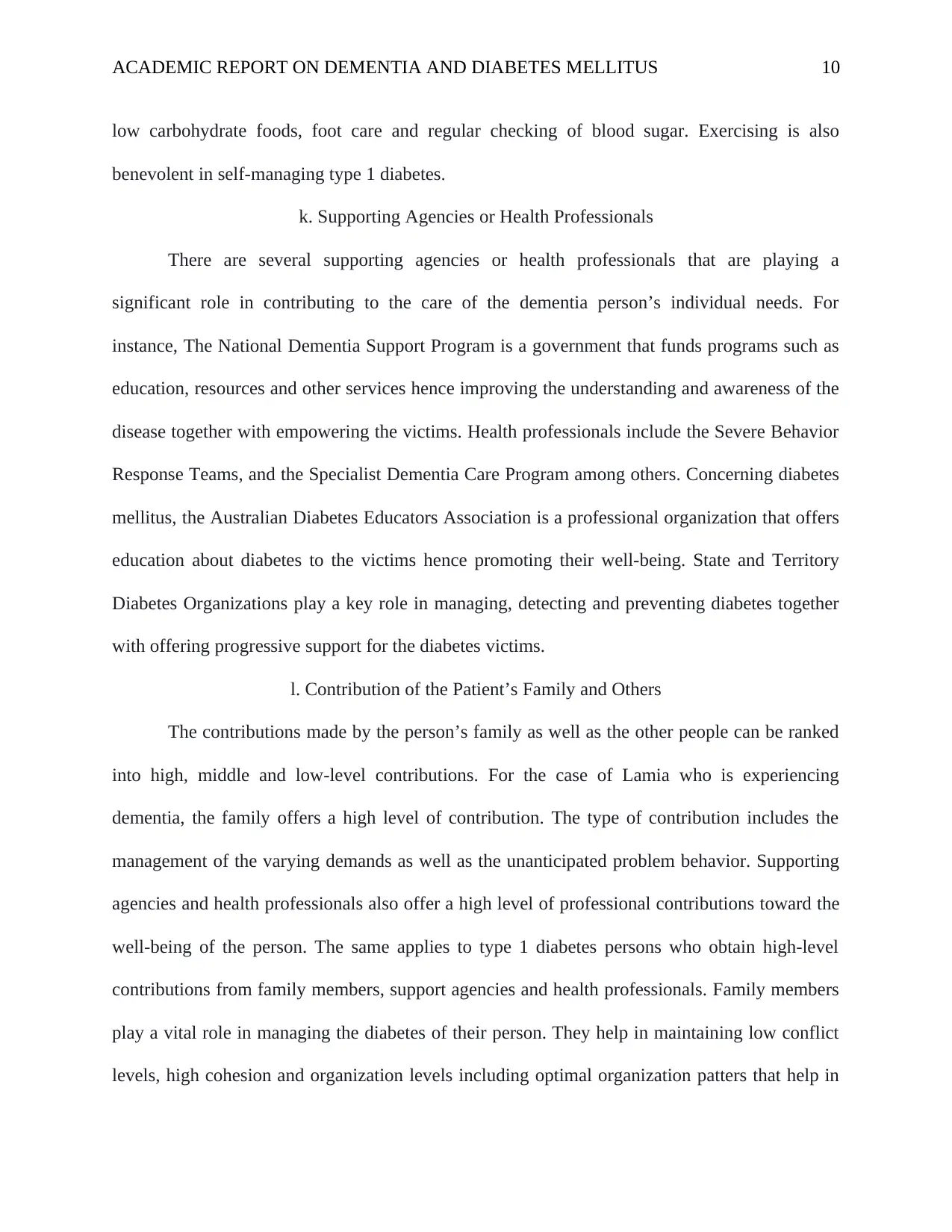
ACADEMIC REPORT ON DEMENTIA AND DIABETES MELLITUS 10
low carbohydrate foods, foot care and regular checking of blood sugar. Exercising is also
benevolent in self-managing type 1 diabetes.
k. Supporting Agencies or Health Professionals
There are several supporting agencies or health professionals that are playing a
significant role in contributing to the care of the dementia person’s individual needs. For
instance, The National Dementia Support Program is a government that funds programs such as
education, resources and other services hence improving the understanding and awareness of the
disease together with empowering the victims. Health professionals include the Severe Behavior
Response Teams, and the Specialist Dementia Care Program among others. Concerning diabetes
mellitus, the Australian Diabetes Educators Association is a professional organization that offers
education about diabetes to the victims hence promoting their well-being. State and Territory
Diabetes Organizations play a key role in managing, detecting and preventing diabetes together
with offering progressive support for the diabetes victims.
l. Contribution of the Patient’s Family and Others
The contributions made by the person’s family as well as the other people can be ranked
into high, middle and low-level contributions. For the case of Lamia who is experiencing
dementia, the family offers a high level of contribution. The type of contribution includes the
management of the varying demands as well as the unanticipated problem behavior. Supporting
agencies and health professionals also offer a high level of professional contributions toward the
well-being of the person. The same applies to type 1 diabetes persons who obtain high-level
contributions from family members, support agencies and health professionals. Family members
play a vital role in managing the diabetes of their person. They help in maintaining low conflict
levels, high cohesion and organization levels including optimal organization patters that help in
low carbohydrate foods, foot care and regular checking of blood sugar. Exercising is also
benevolent in self-managing type 1 diabetes.
k. Supporting Agencies or Health Professionals
There are several supporting agencies or health professionals that are playing a
significant role in contributing to the care of the dementia person’s individual needs. For
instance, The National Dementia Support Program is a government that funds programs such as
education, resources and other services hence improving the understanding and awareness of the
disease together with empowering the victims. Health professionals include the Severe Behavior
Response Teams, and the Specialist Dementia Care Program among others. Concerning diabetes
mellitus, the Australian Diabetes Educators Association is a professional organization that offers
education about diabetes to the victims hence promoting their well-being. State and Territory
Diabetes Organizations play a key role in managing, detecting and preventing diabetes together
with offering progressive support for the diabetes victims.
l. Contribution of the Patient’s Family and Others
The contributions made by the person’s family as well as the other people can be ranked
into high, middle and low-level contributions. For the case of Lamia who is experiencing
dementia, the family offers a high level of contribution. The type of contribution includes the
management of the varying demands as well as the unanticipated problem behavior. Supporting
agencies and health professionals also offer a high level of professional contributions toward the
well-being of the person. The same applies to type 1 diabetes persons who obtain high-level
contributions from family members, support agencies and health professionals. Family members
play a vital role in managing the diabetes of their person. They help in maintaining low conflict
levels, high cohesion and organization levels including optimal organization patters that help in
Paraphrase This Document
Need a fresh take? Get an instant paraphrase of this document with our AI Paraphraser
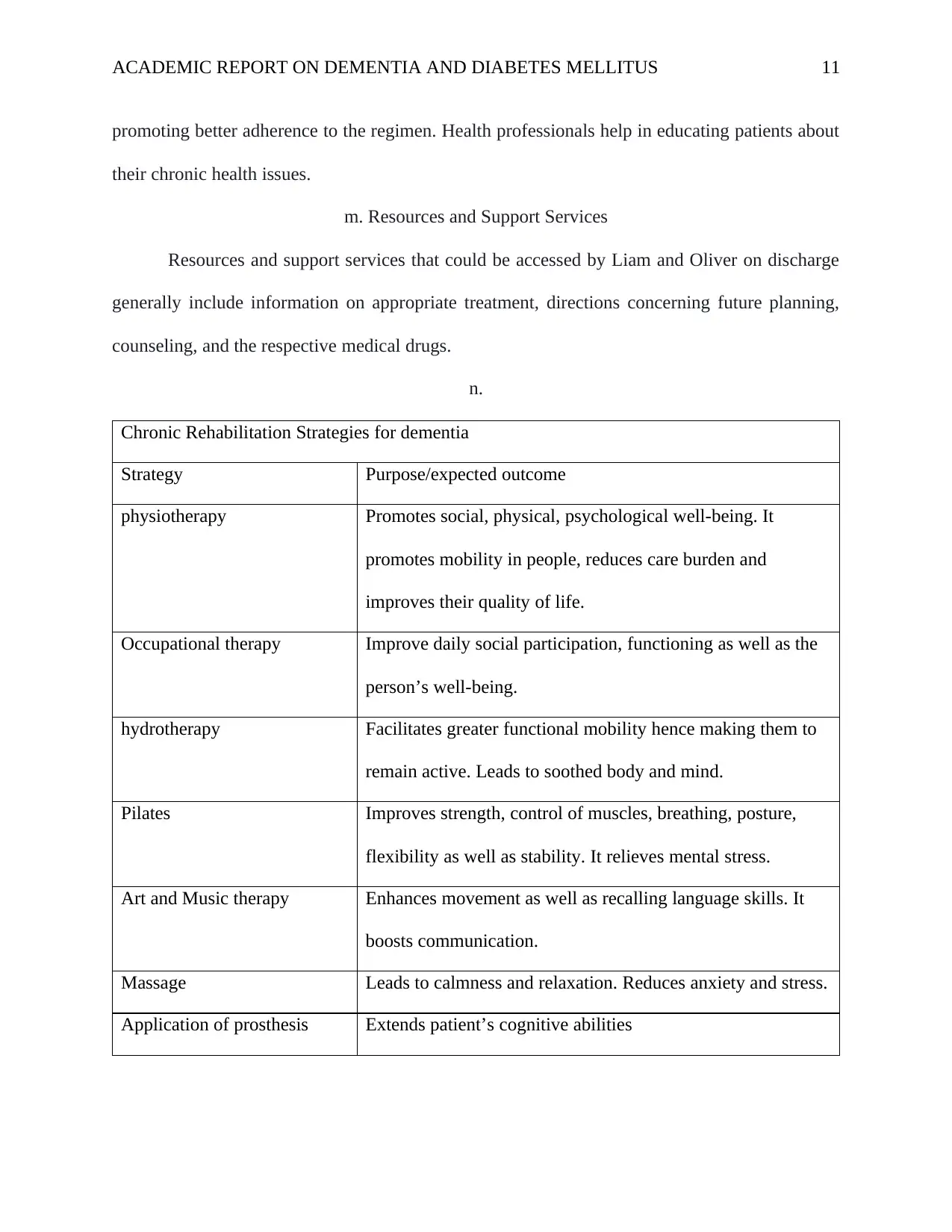
ACADEMIC REPORT ON DEMENTIA AND DIABETES MELLITUS 11
promoting better adherence to the regimen. Health professionals help in educating patients about
their chronic health issues.
m. Resources and Support Services
Resources and support services that could be accessed by Liam and Oliver on discharge
generally include information on appropriate treatment, directions concerning future planning,
counseling, and the respective medical drugs.
n.
Chronic Rehabilitation Strategies for dementia
Strategy Purpose/expected outcome
physiotherapy Promotes social, physical, psychological well-being. It
promotes mobility in people, reduces care burden and
improves their quality of life.
Occupational therapy Improve daily social participation, functioning as well as the
person’s well-being.
hydrotherapy Facilitates greater functional mobility hence making them to
remain active. Leads to soothed body and mind.
Pilates Improves strength, control of muscles, breathing, posture,
flexibility as well as stability. It relieves mental stress.
Art and Music therapy Enhances movement as well as recalling language skills. It
boosts communication.
Massage Leads to calmness and relaxation. Reduces anxiety and stress.
Application of prosthesis Extends patient’s cognitive abilities
promoting better adherence to the regimen. Health professionals help in educating patients about
their chronic health issues.
m. Resources and Support Services
Resources and support services that could be accessed by Liam and Oliver on discharge
generally include information on appropriate treatment, directions concerning future planning,
counseling, and the respective medical drugs.
n.
Chronic Rehabilitation Strategies for dementia
Strategy Purpose/expected outcome
physiotherapy Promotes social, physical, psychological well-being. It
promotes mobility in people, reduces care burden and
improves their quality of life.
Occupational therapy Improve daily social participation, functioning as well as the
person’s well-being.
hydrotherapy Facilitates greater functional mobility hence making them to
remain active. Leads to soothed body and mind.
Pilates Improves strength, control of muscles, breathing, posture,
flexibility as well as stability. It relieves mental stress.
Art and Music therapy Enhances movement as well as recalling language skills. It
boosts communication.
Massage Leads to calmness and relaxation. Reduces anxiety and stress.
Application of prosthesis Extends patient’s cognitive abilities
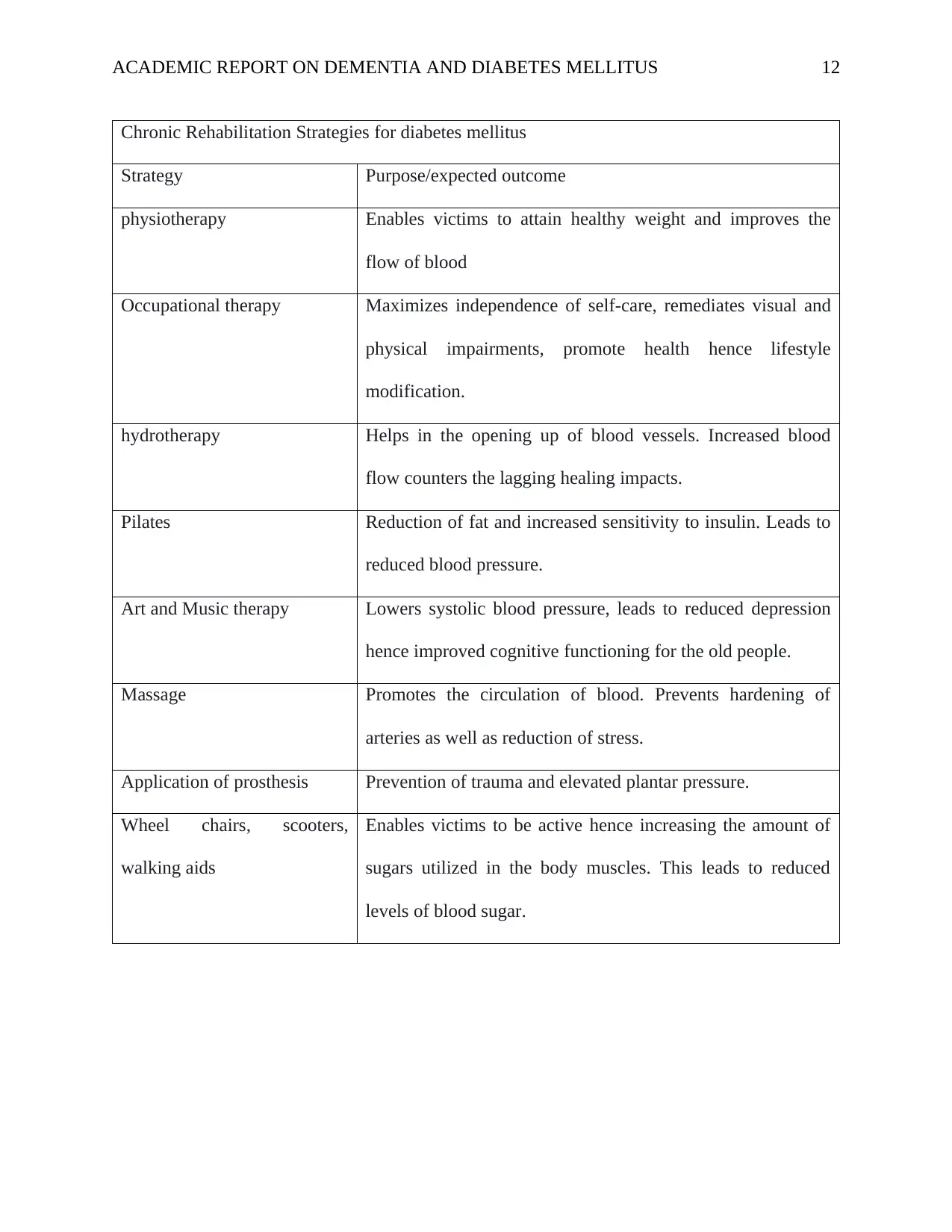
ACADEMIC REPORT ON DEMENTIA AND DIABETES MELLITUS 12
Chronic Rehabilitation Strategies for diabetes mellitus
Strategy Purpose/expected outcome
physiotherapy Enables victims to attain healthy weight and improves the
flow of blood
Occupational therapy Maximizes independence of self-care, remediates visual and
physical impairments, promote health hence lifestyle
modification.
hydrotherapy Helps in the opening up of blood vessels. Increased blood
flow counters the lagging healing impacts.
Pilates Reduction of fat and increased sensitivity to insulin. Leads to
reduced blood pressure.
Art and Music therapy Lowers systolic blood pressure, leads to reduced depression
hence improved cognitive functioning for the old people.
Massage Promotes the circulation of blood. Prevents hardening of
arteries as well as reduction of stress.
Application of prosthesis Prevention of trauma and elevated plantar pressure.
Wheel chairs, scooters,
walking aids
Enables victims to be active hence increasing the amount of
sugars utilized in the body muscles. This leads to reduced
levels of blood sugar.
Chronic Rehabilitation Strategies for diabetes mellitus
Strategy Purpose/expected outcome
physiotherapy Enables victims to attain healthy weight and improves the
flow of blood
Occupational therapy Maximizes independence of self-care, remediates visual and
physical impairments, promote health hence lifestyle
modification.
hydrotherapy Helps in the opening up of blood vessels. Increased blood
flow counters the lagging healing impacts.
Pilates Reduction of fat and increased sensitivity to insulin. Leads to
reduced blood pressure.
Art and Music therapy Lowers systolic blood pressure, leads to reduced depression
hence improved cognitive functioning for the old people.
Massage Promotes the circulation of blood. Prevents hardening of
arteries as well as reduction of stress.
Application of prosthesis Prevention of trauma and elevated plantar pressure.
Wheel chairs, scooters,
walking aids
Enables victims to be active hence increasing the amount of
sugars utilized in the body muscles. This leads to reduced
levels of blood sugar.
⊘ This is a preview!⊘
Do you want full access?
Subscribe today to unlock all pages.

Trusted by 1+ million students worldwide
1 out of 15
Related Documents
Your All-in-One AI-Powered Toolkit for Academic Success.
+13062052269
info@desklib.com
Available 24*7 on WhatsApp / Email
![[object Object]](/_next/static/media/star-bottom.7253800d.svg)
Unlock your academic potential
Copyright © 2020–2025 A2Z Services. All Rights Reserved. Developed and managed by ZUCOL.





